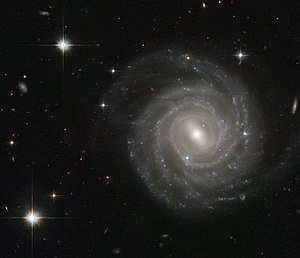UGC 12158
| UGC 12158 | |
|---|---|
 Barred spiral galaxy UGC 12158 | |
| Observation data (J2000 epoch) | |
| Constellation | Pegasus |
| Right ascension | 22h 42m 10.496s[1] |
| Declination | 19° 59′ 49.21″[1] |
| Redshift | 0.030985[2] |
| Helio radial velocity | 9,289 km/s[2] |
| Distance | 384 million ly (117.86 Mpc)[2] |
| Apparent magnitude (V) | 14.5[2] |
| Apparent magnitude (B) | 15.3[2] |
| Characteristics | |
| Type | Sb or Sb D[2] |
| Apparent size (V) | 1.2' × 1.1'[2] |
| Other designations | |
| PGC 69533, UGC 12158, MCG+03-57-032, 2MASX J22421049+1959492, SDSS J224210.53+195948.8, GALEXASC J224210.44+195949.5 [2] | |
UGC 12158 or PGC 69533 is an Sb-type barred spiral galaxy located approximately 384,000,000 ly (118 Mpc) away from Earth in the constellation of Pegasus. Its tight spiral disk spans approximately 140,000 ly (40 kpc) across, whose scale at heliocentric distance is about 36.9 kiloparsecs per arcmin.[2] It is also often stated to resemble the Milky Way in appearance, with a similar central bar and spiral arm structure.[3]
2003 Supernova[]
On 15 December 2003, a 19.2v magnitude Type Ia supernova, was recorded on one of the spiral arms near the apparent centre in UGC 12158, and was designated as SN 2004EF.[4] (Blue star within UGC 12158 in Starbox Hubble's Space Telescope image.[5]) It reached 17.5v magnitude on 4 September 2004 before fading from view. [6] Optical spectra was obtained on 7 September 2014 confirming the Type I classification.[7] No progenitor star was found on earlier survey images.[6]
See also[]
- NGC 2336 - another spiral galaxy of similar size and shape
- NGC 1232
- NGC 6744
- SPT0418-47 - a spiral galaxy of similar size and shape when universe was 1.4 billion years old
References[]
- ^ a b "PGC 69533". SIMBAD. Centre de données astronomiques de Strasbourg. Retrieved May 17, 2017.
- ^ a b c d e f g h i "NED results for object PGC 069533". NASA/IPAC Extragalactic Database. Retrieved May 17, 2017.
- ^ "The Milky Way's (almost) identical twin". Phil Plait. Retrieved May 17, 2017.
- ^ "Supernova 2004ef in UGC 12158". David Bishop. Retrieved December 14, 2016.
- ^ "The Milky Way's (almost) identical twin". Phil Platt. Retrieved May 17, 2017.
- ^ a b T., Boles; M., Armstrong (2004). "Supernova 2004ef in UGC 12158". IAU Circular. 8403: 2. Bibcode:2004IAUC.8403....2F.
- ^ G., Folatelli; et al. (2004). "Supernova 2004ef in UGC 12158". IAU Circular. 8399: 2. Bibcode:2004IAUC.8399....2B.
External links[]
 Media related to UGC 12158 at Wikimedia Commons
Media related to UGC 12158 at Wikimedia Commons- Barred spiral bares all
- The Milky Way's (almost) identical twin
- UGC objects
- Pegasus (constellation)
- Barred spiral galaxies
- Principal Galaxies Catalogue objects
- Spiral galaxy stubs